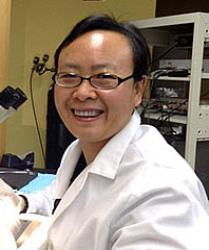

 Assistant Professor of Pharmacology
Assistant Professor of PharmacologyE-mail: daohong_lin@nymc.edu
Tel: 914-594-3870/4120
Mail:
Department of Pharmacology
Basic Science Building, Rm. 534
15 Dana Road
Valhalla, NY 10595
Professional Interests
Inwardly rectifying potassium channels (Kirs) play a critical role in mediating renal K secretion. We have found that basolateral Kcnj10 expression determines the apical Na-Cl cotransporter in distal convoluted tubule (DCT). However, the underlying mechanism remains largely unknown. My research goal is to explore the mechanism of posttranslational regulation of Kirs channels in the non-excitable epithelial cells, such as renal DCT cells, in response to low potassium diet intake. In addition, I have demonstrated that Kcnj10 is a major Kir channel and determines the membrane potential in DCT epithelial cell. Furthermore, my recent work shows that Kir5.1, a co-expressed protein with Kir4.1, mediates nedd4-2-induced ubiquitination of Kir4.1 which in turn to decrease Kir4.1 activity. My current ongoing research interest expands to study the regulation of Kir5.1 in modulating Kir4.1 in response to high Na or high K diets.
KCNJ10 (Kir4.1) is expressed in the basolateral membrane of the cortical thick ascending limb.
Inwardly rectifier K channels (Kirs) encoded by the KCNJ genes are responsible for generating the cell membrane potential. Kir is constitutively active in cell membranes, favoring K influx more than efflux crossing membrane, thereby modulating membrane potential, K+ hemostasis and trans-epithelial voltage gradient. Loss-of-function mutations in KCNJ10 have been associated with the autosomal recessive SeSAME syndrome (Seizures, Sensorineural deafness, Ataxia, Mental retardation, and Electrolyte imbalance, SeSAME), also known as EAST syndrome (Epilepsy, Ataxia, Sensorineural deafness, and Tubulopathy, EAST). By using Kcnj10+/+ wild-type (WT) and Kcnj10-/- knockout (KO) mice, we have found that Kcnj10 (Kir4.1) in contributing to the basolateral K conductance in the cortical thick ascending limb (cTAL). Moreover, the gene disruption of Kcnj10 did not affect the expression of Na-K-Cl cotransporter 2 (NKCC2) but determines the apical Na-Cl cotransporter (NCC) expression in DCT, possibly through a Ste20-related proline-alanine-rich kinase-dependent mechanism (Fig.1).
The role and regulation of Kir5.1 in mediating the effect of dietary potassium intake on Kir4.1.
Dietary K+ intake plays an important role in regulating NCC such that a high K+ intake (HK) decreases while a low K+ intake increases NCC. Our previous study has demonstrated that Kir4.1 plays an important role in mediating the effect of dietary K+ intake on NCC expression and activity since the deletion of Kir4.1 not only caused K+ wasting but also abolished the effect of dietary K+ intake on NCC. We now test the hypothesis that Kir5.1 is required for the effect of HK intake on the basolateral K+ channel activity of the DCT and apical NCC function.
Selected Publications: